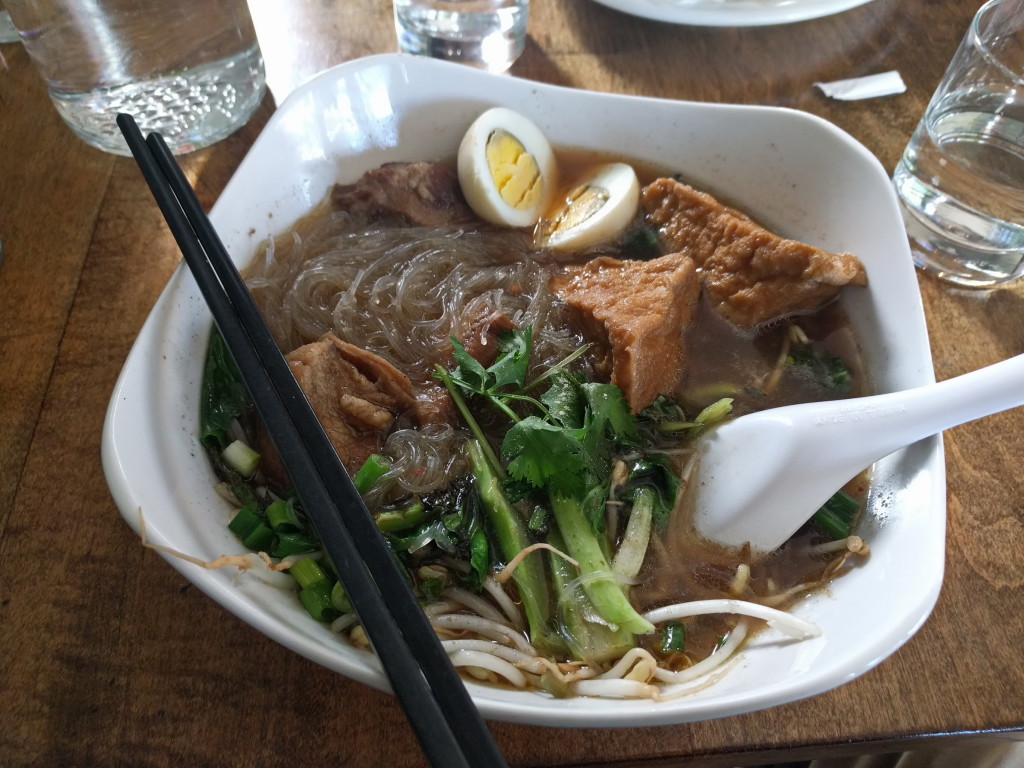Category: Food
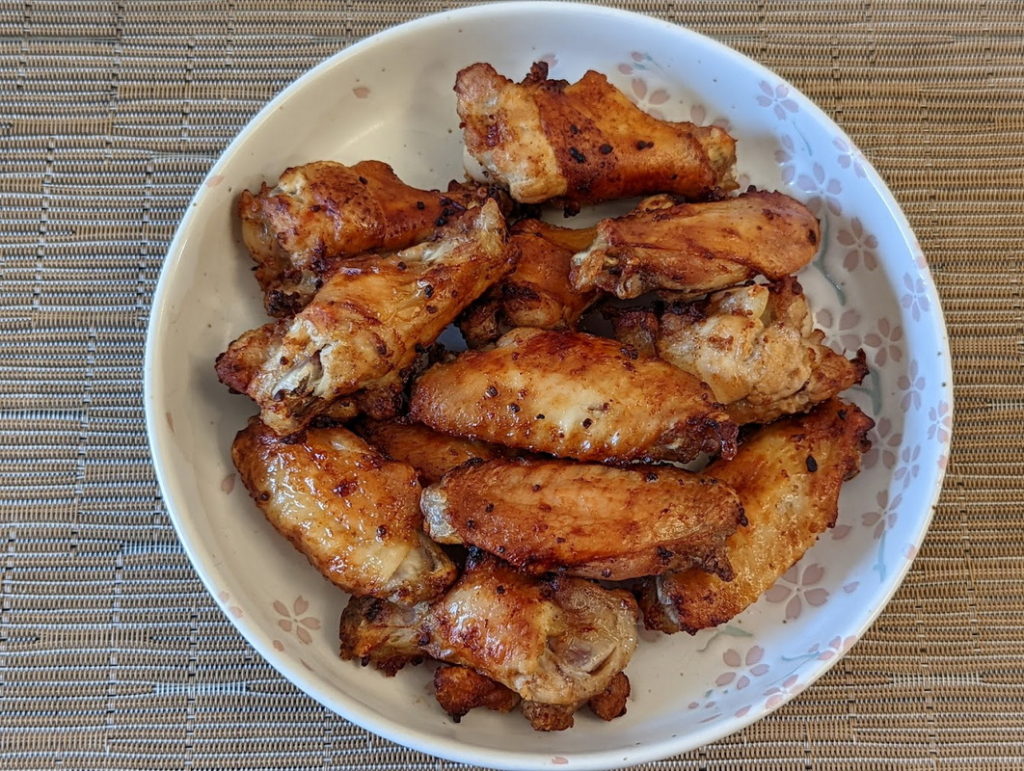
This recipe is baked, not deep-fried. Makes crispy, juicy wings.
Prep Time: 10 Minutes Cook Time: 40 minutes Servings: 2
INGREDIENTS:
6-10 chicken wings (get plump party wings); or 6-8 thigh
3 tablespoons olive oil
3 cloves garlic, minced (or 3 tsp. of minced garlic from jar)
1/2 teaspoons chili powder
1 teaspoon garlic powder
1/2 tsp. salt, and ground black pepper to taste
DIRECTIONS
1. Preheat the oven to 400° F (convection)
2. Combine the chicken, olive oil, garlic, chili powder, garlic powder, salt, and pepper in a large mixing bowl. Arrange the chicken wings on a baking sheet.
3. Cook the wings in the preheated oven 40 minutes (turn over at 20 min.), or until crisp and cooked through.
AIR FRYER CHICKEN WINGS (20-minute cook time):
INGREDIENTS
- 1.5-2 lbs party wings cut into drumettes and flats (e.g. Fred Meyer Foster Farms Organic)
- Seasoning is the same as above.
DIRECTIONS
- Set Ninja Air Fryer at “Air Crisp” for 17 minutes at 300°F.
- Place the chicken wings into the Ninja Air fryer.
- Lift the cover to check doneness.
- When the time is up, flip the wings over, increase the temperature to 390°F, and bake for 5 more minutes until the skin is browned and crisp.
- Transfer to a bowl.
Date: August 17, 2015 Publication: Daily Health News
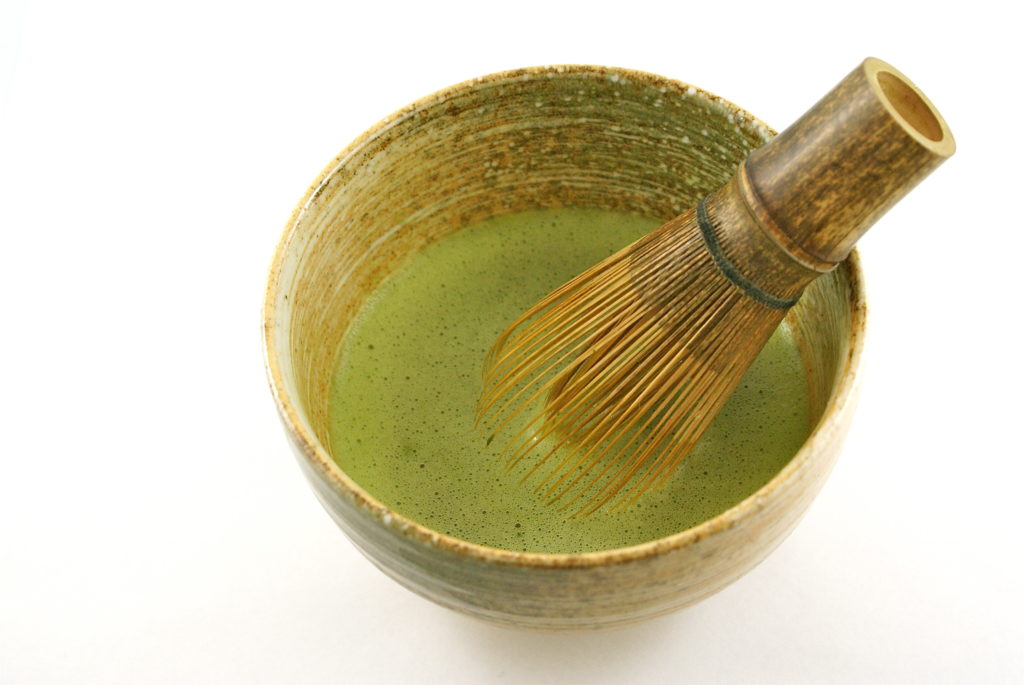
You know green tea is really good for you. Its antioxidant compounds show up in studies as protective against heart disease, diabetes, cancer, dementia, obesity and more. But you’re probably not going to start drinking four or more cups every day—even 10 cups a day in some studies—like many Chinese and Japanese people do.
The models at Fashion Week in New York City had a solution. Backstage, for energy and Zen balance, they sipped little shots of matcha green tea, a specific kind that contains unusually high levels of antioxidants. There’s also matcha tea powder that has become today’s “it” ingredient in everything from smoothies to latte to fruit pops to very, very green muffins. Matcha, it seems, is suddenly and literally on everyone’s lips.
Does it deserve the hype? There’s no question that it can be a very healthy beverage or even recipe ingredient. But now that it’s a fad, and everyone’s getting into the act, be careful about matcha products that are unhealthy—or even unsafe…because they are contaminated with heavy metals. So it pays to be matcha savvy. Here’s what you need to know to safely benefit from this unique form of green tea.
GOOD STUFF IN A SMALL PACKAGE
For matcha, concentration is the name of the game. It’s made from green tea, so it contains the powerful antioxidant epigallocatechin gallate (EGCG), responsible for many of green tea’s health benefits, as well as the amino acid L-theanine, which has antianxiety properties (more about that in a moment).
It has about three times as much EGCG as standard brewed green tea, according to some estimates. It also has about as much caffeine as a cup of coffee.
How does matcha deliver this bioactive bounty? It’s a combination of how it’s grown and how it’s prepared. Unlike with other varieties, a few weeks before harvest, the plant is covered from the sun, which causes it to produce more EGCG and L-theanine. Another unusual step: After harvest, the leaves are ground into a fine powder. And matcha is also prepared differently. When you drink matcha, you’re actually drinking a “suspension” of ground leaves infused in water, rather than a typical brew where leaves are steeped and then removed from the cup or pot. Hence, you are actually consuming the leaves and, along with them, more green tea compounds.
The L-theanine may be responsible for one of matcha’s coveted benefits—a pleasant sense that users say it brings that may be described as “alert calmness.” Credit caffeine for the alertness, of course. L-theanine, on the other hand, has been shown in studies to reduce anxiety.
MATCHA DOs—AND ONE BIG DON’T
Matcha has long been appreciated in the East. In Japan it forms part of the traditional tea ceremony and is the most revered form of tea. Because matcha involves consuming the entire tea leaf, however, the origin of any matcha powder you consume is extremely important for your safety. Here’s what you need to know…
• Tea plants grown in soil that is contaminated with lead will absorb it into the leaves, and, because you are consuming the entire leaf, more lead may wind up in your cup. In one study from the research organization ConsumerLab, tea grown in China had high lead concentrations.
• Your best bet: Stick to matcha teas grown in Japan, and look for brands that report consistent testing for the presence of heavy metals. In the ConsumerLab’s study, for example, the one tea tested that came from Japan, Teavana, had no detectable lead.
• The highest-quality matcha comes from the southern regions of Japan—Kyushu, Nishio, Shizuoka and Uji.
• Good-quality matcha is bright, vivid green and will have a find powdery consistency—anything yellowish or coarse is not likely to taste very good.
• Expect to pay about $26 to $32 for a standard 30-gram tin (about an ounce). Anything cheaper is not likely to have good flavor.
• One cup of matcha calls for about one gram of dry powder, so a 30-gram tin should give you a cup of matcha tea every day for a month. (You can get a special measuring spoon from a matcha supplier, along with a whisk to prepare the tea in a bowl.)
• Now that matcha has become popular in the US, some prepared versions may have plenty of added sugar. Skip them, and make the real thing yourself.
• Ready to try it? Here’s a quick video tutorial from Kenko Tea, an Australian brand that gets its matcha from the Nishio region of Japan and ships worldwide. Other reputable brands include DoMatcha, and MidoriSpring.
So go ahead, enjoy your own tea ceremony. Matcha has a grassy, slightly bitter flavor…some people compare it to that of kale or spinach. You can try it the traditional way or experiment with adding the powder to recipes. Just remember that tossing matcha into your 1,000-calorie ice cream milkshake doesn’t suddenly turn it into a health drink!
This info from fedupmovie.com
See: Dr. Robert Lustig Videos:
Sugar: the Bitter Truth
Fat Chance: Fructose 2.0
60 Minutes
1980: Childhood Type 2 diabetes: 0 cases.
2010: 57,600+ cases
1977, Because of McGovern Report, food industry started taking fat out of foods, and replacing it with sugar. Between 1977 and 2010, average consumption of sugar by Americans doubled.
Ignore calories in/calories out prescription. It’s not about exercise. It’s about too much processed sugar in.
AHA daily allowance of added sugar: 6-9 tsp. (4 grams per tsp). 36 grams max. a day.
Food addiction is real, not a metaphor. People’s responsibility doesn’t work in the face of addiction. Don’t have addictive food in the house.
WHO TRS-916. Sugar is the major, if not the cause of chronic metabolic disease and obesity. No more than 10% of daily should come from sugar. USA extorted WHO to stop publication of report. 4 calories in one gram of sugar. 4×36 = 144 calories. 10% of 1,500 calories = 150 calories.
Simple carbs (e.g. white bread, white rice, processed cereal) act the same as sugar in the body.
One can be metabolically obese and normal weight, and in danger of heart disease, diabetes, etc. Tofi = Thin on outside, fat inside. DEXA scan = measures internal body fat. Belly fat is the dangerous fat. 40% of normal weight have metabolic disease.
Insulin coverts sugar to fat storage.

Miso-Glazed Black Cod
“This is my take on the oft requested miso-glazed, black cod, made famous by chef Nobu Matsuhisa. In addition to a taste and texture to die for, this is one of the easiest fish recipes of all time. A couple minutes to make the sauce, some brushing, a short wait, and you’re broiling. By the way, I don’t like to cook both sides. I like the heat to only penetrate from the top down. This makes for a lovely caramelized top, and a super juicy interior. Cooking times will vary, but simply broil the fish until the bones pull out with no effort, and the meat flakes.”
Ingredients
- 3 tablespoons white miso paste
- 2 tablespoons water
- 2 tablespoons mirin (Japanese sweet wine)
- 2 tablespoons sake
- 1 tablespoon brown sugar
- Some minced ginger (suggested by Ling)
- 2 (7 ounce) black cod fillets
Directions
- Set oven rack about 6 inches from the heat source and preheat the oven’s broiler. Line a baking sheet with aluminum foil and lightly grease the aluminum foil.
- Whisk miso paste, water, mirin, sake, and brown sugar together in a small skillet over medium heat until mixture simmers and thickens slightly, 1 to 3 minutes. Remove from heat and cool completely.
- Place cod fillets on prepared baking sheet. Brush fillets all over with miso mixture. Rest fillets at room temperature to quickly marinate, 15 to 20.
- Broil fillets in the preheated oven for 5 minutes. Turn the baking sheet 180 degrees and continue broiling until fish flakes easily with a fork, about 5 minutes more. Sprinkle lightly with salt.
Some nice easy to follow recipes:
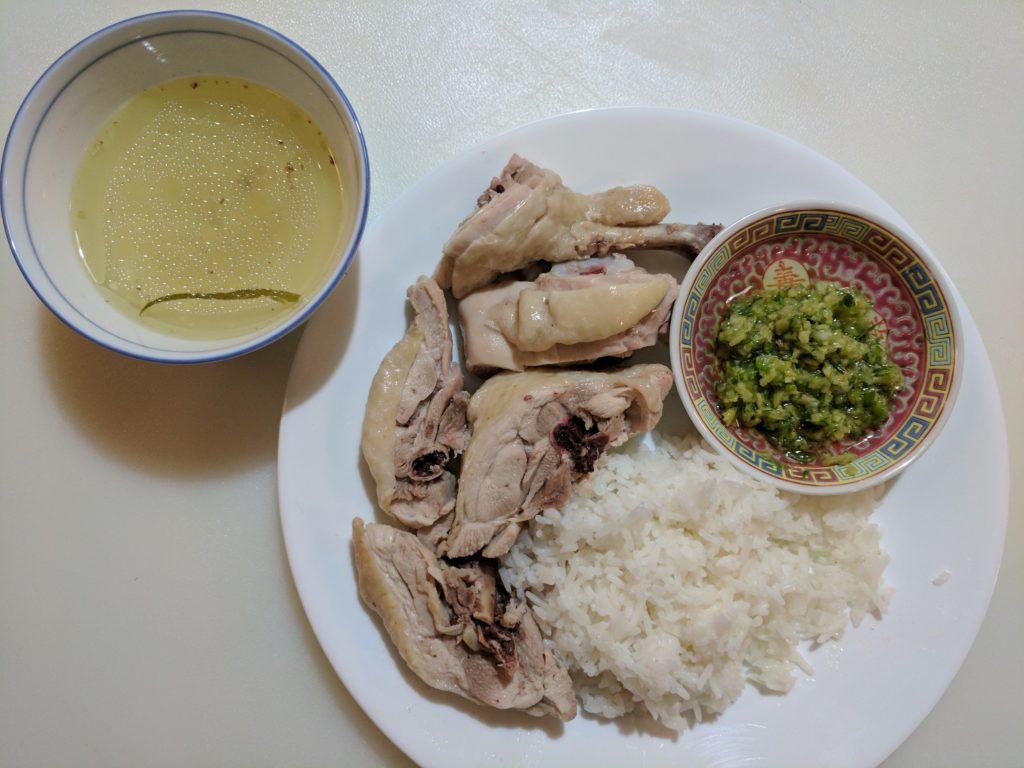
INGREDIENTS
- Chicken stock (with 4 smashed ginger slices and 2 whole scallions) enough to cover chicken, usually about 4 cups or more
- Whole chicken1 (ideally 3 lb) – washed, loose fat removed and set aside
- Ginger – enough for four thick unpeeled slices for stock and at least 3 TBSP peeled & grated for sauce, about 4-5” knob
- Scallions – 2 whole for stock and at least 3 TBSP of minced white part w/ a touch of the light green part minced, for colour, about 1 bunch
- Grapeseed or avocado oil – almost 4 TBSP, enough to mix with desired quantity of ginger/ scallions (equal parts) to make a paste, roughly about 2/3 of the amount of ginger/ scallion
- Salt
DIRECTIONS
- Wash chicken, remove anything loose inside, pat dry and rub with salt. After 5 minutes rinse off salt and leave chicken to drain.
- Bring stock with ginger slices and scallions to boil.
- Lower chicken gently into boiling stock to cover, breast side up
- Reduce heat to medium and bring stock with chicken back to rolling boil, in uncovered pot. (Gentler heat is better – more tender – and will require less standing time in the liquid off the burner afterwards).
- Turn off heat (not remove from) and keep covered and undisturbed for 30 – 60 mins
- Check after 30 mins by inserting skewer into thigh – it’s done when the small puncture draws clear liquid (or to temp of 165° – which is too much for chicken breast in my opinion)
- Remove bird from pot (with wooden spoon inserted into cavity so as not to break the skin), rub skin with sesame oil and place in freezer2 for ten minutes to stop cooking process.
- Transfer to cutting board and remove the back by cutting with poultry shears up either side of the tail (set aside for private nibbling or to add to mother stock – I always eat the tail, yum!). Slice off legs and wings, and split breast in half, before cutting all cleanly Chinese style, with a cleaver.3
- Lay out on platter in the shape of a whole, flattened chicken. Serve with finely trimmed green part of scallions (slightly curled)* and with dipping sauce. Your chicken may have a slight pink tint to it which is normal – it IS cooked! If this grosses out your guests, cook it longer in the poaching liquid.
- Reserve (freeze) stock for next time – the richer it gets, the more flavour for your chicken, until you want to use your stock for soup!
- Use (freeze) reserved chicken fat for cooking rice or stir frying vegetables – yumm!
Dipping Sauce:
- Grate 4 or finely mince peeled ginger and white part of scallions (1:1 ratio) with small amount of light green part for colour, and place in heatproof bowl. Do by hand for the right texture or if you are good with the food processor, pulse the mixture carefully to avoid excess liquid or becoming mushy.
- Heat oil until almost smoking, and then pour into minced ginger/ garlic mixture and mix well. (I prefer to do this rather than sautéing the mix, however briefly, because I don’t want to cook them, just warm them and release the flavours.)
- Stir in enough salt to make sauce more than seasoned
1As we prefer dark meat I just use chicken thighs if it is just for us; the only real reason to use a whole chicken would be cost and to recreate the whole chicken on the platter
2 prefer to do this rather than the usual method of putting into an ice bath, to avoid stripping the chicken of any flavours absorbed during cooking.
3To avoid slippage, bone splintering and flying chicken from ill placed cuts, I position the cleaver at the cut location and hit with a rubber mallet.
4Grating the ginger rather than finely mincing it is more of a hassle but extremely rewarding in taste as the finer texture allows for more subtle and integrated flavour
Reivew: Kitzuki Ramen (formerly Kukai)
Kitzuki Ramen is currently my favorite Portland area ramen place. Click on below for photos and comments:
Review: EC Kitchen
Jan V. and I ventured to EC Kitchen, a Taiwanese restaurant, next door to Chinese Delicacy. EC Kitchen is known for unadorned, clean, non-greasy Taiwan style food. We arrived at noon, and saw a single fellow diner, who had ordered beef noodle soup enhanced with tomato. It looked very hearty, but neither one of us felt hungry, and decided to order appetizers from their nice photo menu.
Chewy tofu and steamed buns:
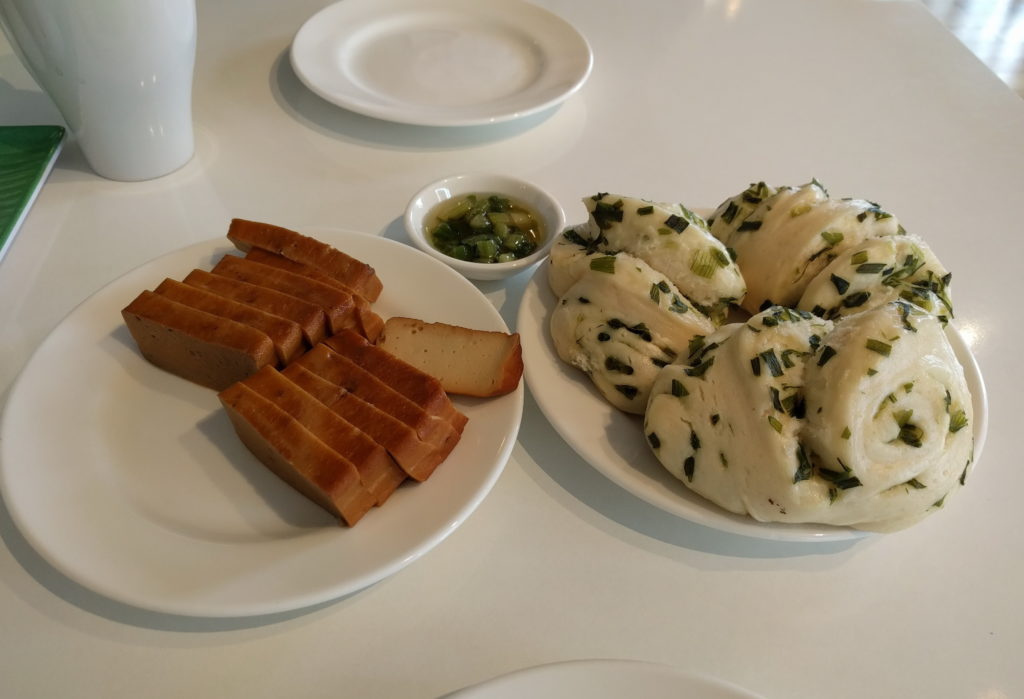
Scallion pancakes:
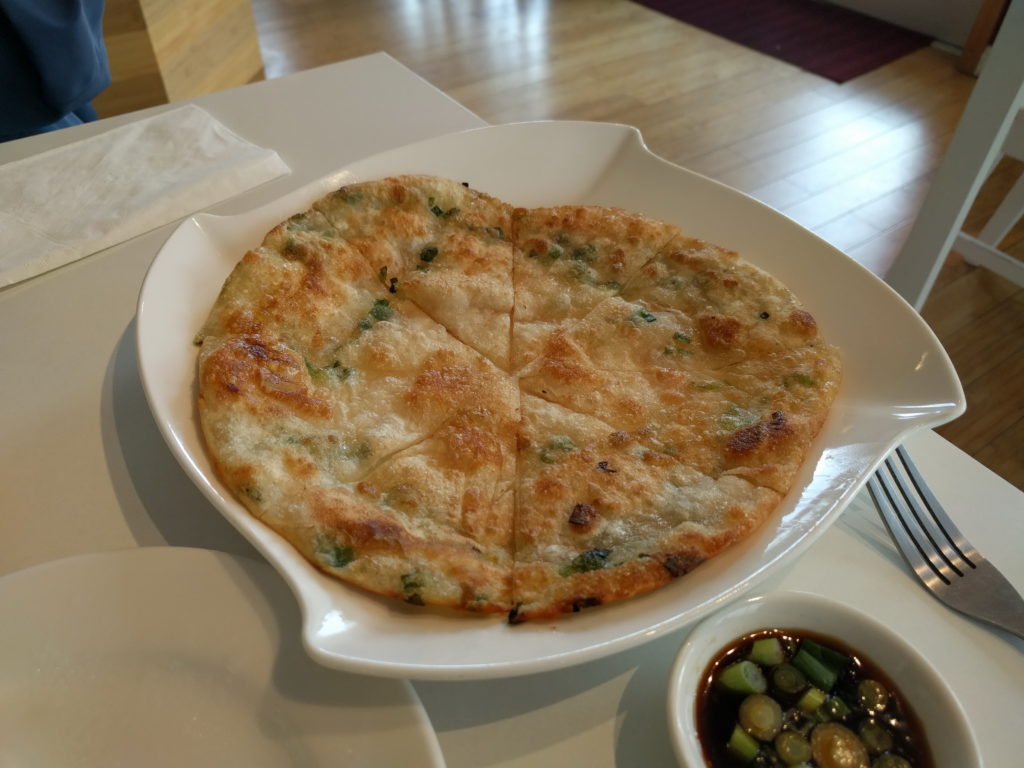
Taiwan style sweet sausage (options: spicy sausage & Cantonese style):
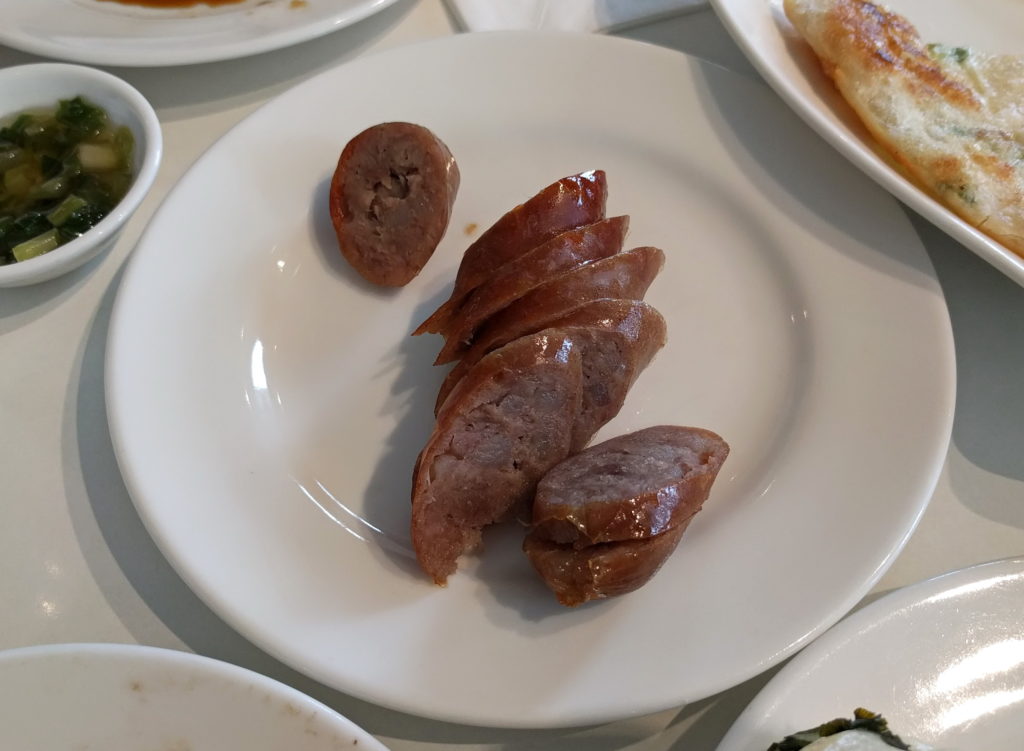
Chive pocket:
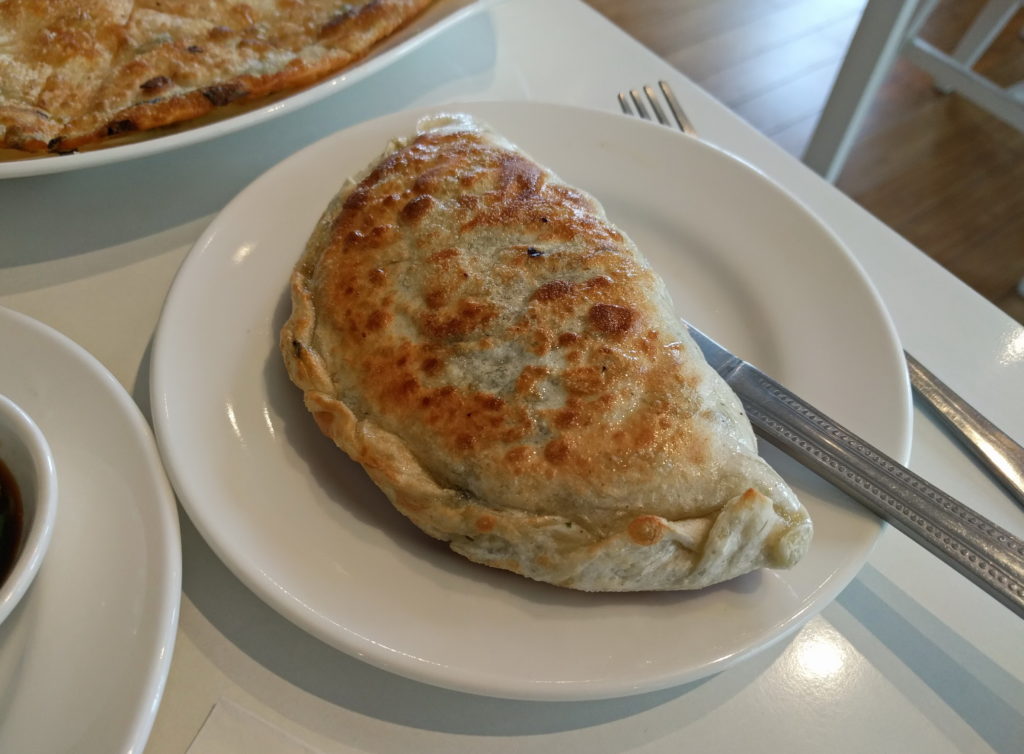
Pork belly bun with pickled veggies and cilantro:
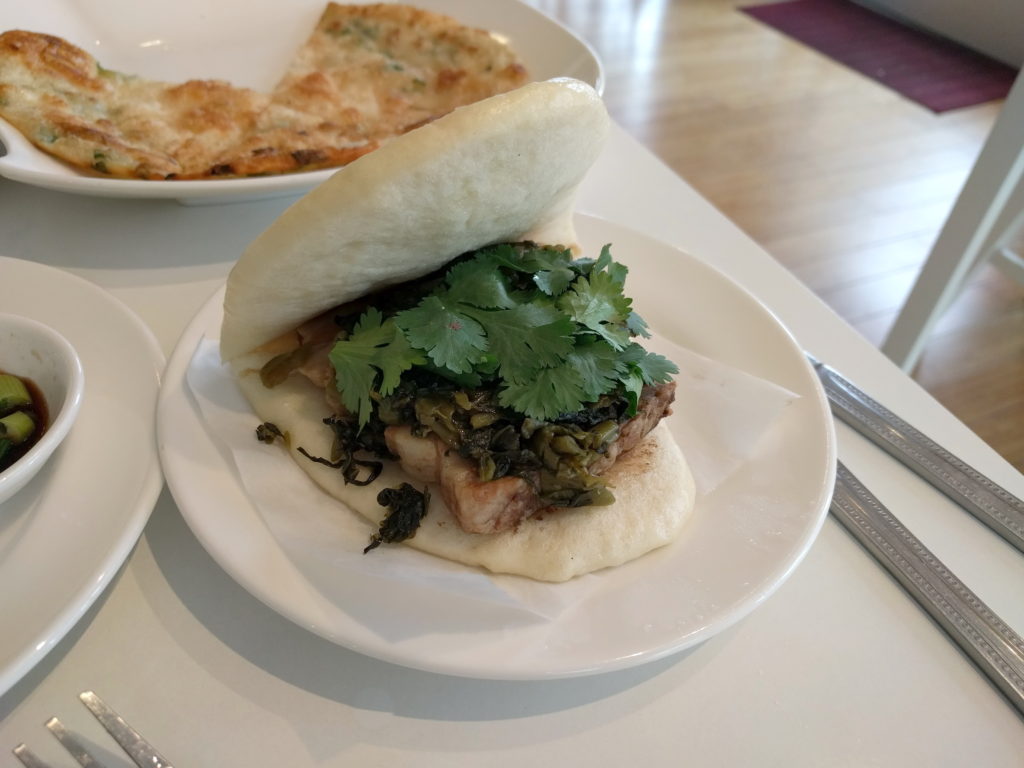
Turnip cake is not pictured, but very good.
We enjoyed the shared appetizers, and rate it a JV “2”; and probably a “3” for well prepared and healthier food. We need to return and try some of their entrees. The beef shank noodle soup sounds good. Their signature items (preservative free sausage, beef shank, and turnip cake) are available in refrigerated units for take out.
Asian soups (other than ramen & pho)
Pho Oregon #27: Hu Tieu My Tho $8.50. Clear noodles with large shrimp, barbecue pork, pork liver, quail egg, and fish balls. Bean sprouts on side plate. A varied mix of meat, veggies, and seafood — clear noodles underneath. Very clean tastes. Nicer decor than most Asian Restaurants.
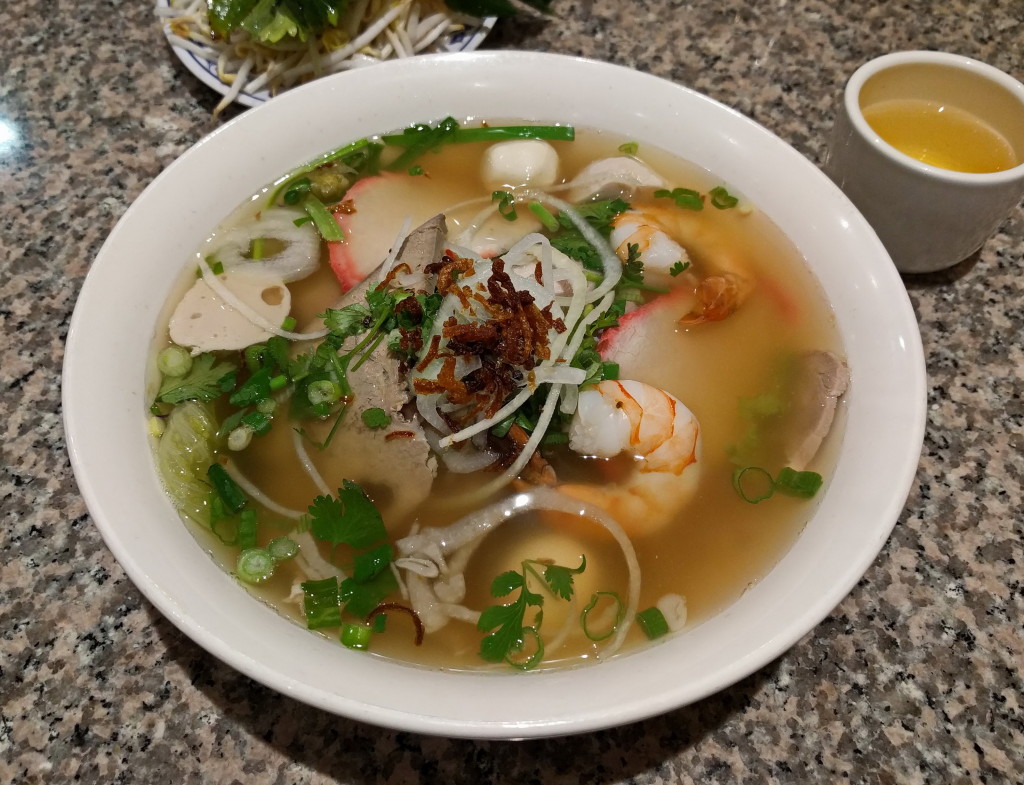
Chiang Mai #30 Kuay Tiew Palo Moo $11.50. Choice of noodles with slow-cooked pork and pork belly, deep-fried tofu, Chinese broccoli, boiled egg, bean sprouts, Chinese brocolli and green onion served in a house special aromatic herbal soup. This dish had woon sen (clear) noodles. Liked the broth. Chiang Mai is northern style Thai.
